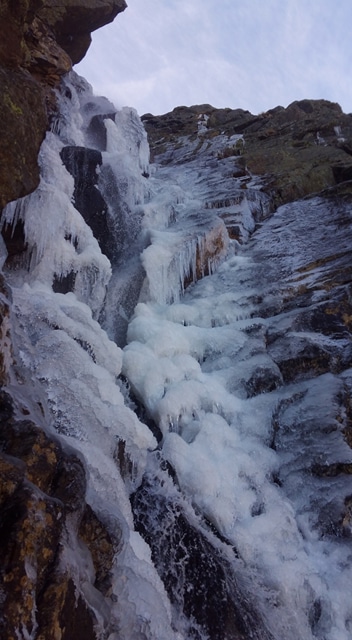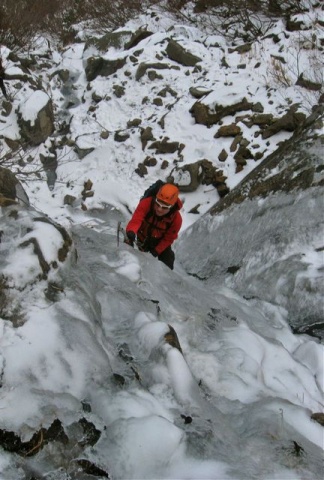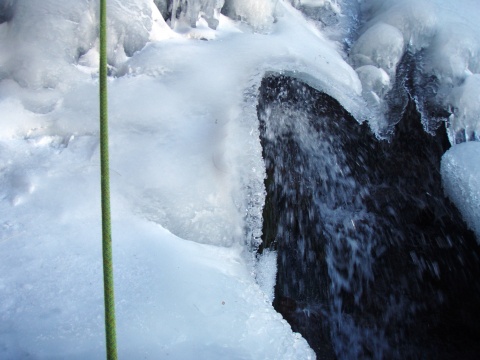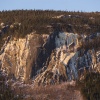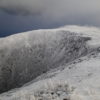The Hazards of Early Season Ice Climbing
And How to Avoid Them
by Doug Millen
Unchecked Ego:
Yes, it’s great to get that early season tick and bragging rights, but the risks are high for those with little experience with early season ice climbing. Are you inexperienced? Think before you ice climb and take an honest look at your skill set, gear and abilities. Your life could depend on it. If you climb WI3+ on a normal day that doesn’t mean you can get up a climb of that grade safely in poor conditions. Often WI3+ climbs are for grade WI5 leaders in the early season.
Falling Ice:
Falling ice is one of the biggest hazards in early season ice climbing. Always be aware of the ice above your climb. Early in the season most ice is not well bonded and frequently falls off, especially later in the day as temperatures rise and the sun works the climb. Early starts are best, and most often are mandatory.
Unbonded ice:
The 2nd greatest hazard is unbonded ice. In the early season, the water, rock and ground are still warm. Ice will build out with those first few cold days, but the bonds to the earth haven’t been established yet and you will often find hollow spaces under the ice. One must determine if the ice can support your weight and if it’s connected to more substantial ice to let you pass safely. The top outs most likely won’t be frozen turf but wet, soft moss over rock. Sometimes the crux is getting off at the top of the climb. You must be prepared and resourceful. Once I topped out on a climb only to find wet, thin, and delaminated ice with no secure way to make it off the climb. I untied one rope and tied it to my tool and then tossed it up unto the woods where it caught a small tree. Then I “batman-ed” up the rope to safety. Aid climbing for sure, but better than taking a fall.
Free-hanging Columns:
Early season free hanging columns are not safe to climb. They are often brittle and candled. Give them time. It takes many freeze / thaw cycles to temper and solidify the ice so it is safe to climb. Also, columns may not be well connected at the top and will not support your weight. Early season columns offer poor protection and very poor sticks for the tools due to the new, candled and brittle ice.
Limited Protection:
This is not sport or gym climbing. Most often the gear you get is just for the head and would not hold a fall. Short screws, Spectres, pins and a small rock rack are standard for most early season ice climbs. Sometimes a small tied off tree in a crack is the best you can hope for. Use anything you can and the more protection you use, the better off you are. At least with a collection of bad gear, it will slow you down should you fall.
Wet and Frozen Ropes:
A wet rope is not as strong as a dry one and there is often a lot of water running early season. If it is a cold day, your ropes could get frozen and useless in no time. Dry-treated ropes are best and be sure to manage your ropes, keeping them out of the water. Your old fuzzy rock climbing rope will act just like a sponge. Leave it home.
Sunshine:
A cloudy day is your friend. The sun can quickly change the condition of your ice climb. Think about what the sun will be doing when you are on the climb. For instance, the upper reaches of Fafnir on Cannon Cliff gets the sun late in the morning, often showering the lower reaches of the climb and the approach to the Black Dike with falling ice. Think ahead as to where the sun will be shining and where you want to be when the sun hits. Any time the sun leaves or shines on a climb it will cause expansion or contraction. This will cause rocks and ice to move and fall off.
Rising Temps:
If the forecast is for rising temperatures think about what that might mean for your ice climb. Above freezing temps at night and rising temps during the day should send up a red flag. Be aware of what the temperatures have been leading up to the day of your climb and plan accordingly. Consecutive days of rising temps are not good. One warm day after many days of cold is not bad and may offer good safe climbing.
~Doug Millen
You may also like: Protecting the Ice We Climb

